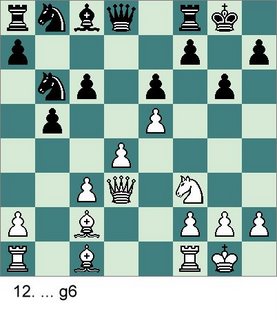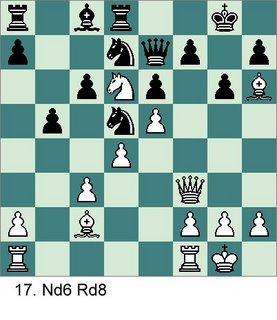1.d4 d5
2.c4 dxc4
 If any of you have been following my Blog (or are chess players,) you would know this is a "Queens Gambit Accepted." And you may also recall me saying "I have a lot of fun with these games." That especially holds true for this game. If anyone is curious, Gambit means to offer something to your opponent hoping to get an advantage, usually in time or position. In the QGA, white offers a pawn to get control of the center.
If any of you have been following my Blog (or are chess players,) you would know this is a "Queens Gambit Accepted." And you may also recall me saying "I have a lot of fun with these games." That especially holds true for this game. If anyone is curious, Gambit means to offer something to your opponent hoping to get an advantage, usually in time or position. In the QGA, white offers a pawn to get control of the center.3.e4 c6
4.Bxc4
 Black usually can't hold onto the gambited pawn and usually gives it back hoping to get some counter play against a pinned knight on c3. Those games that black actually tries to hold onto the extra pawn usually forces black into some very ugly pawn structures.
Black usually can't hold onto the gambited pawn and usually gives it back hoping to get some counter play against a pinned knight on c3. Those games that black actually tries to hold onto the extra pawn usually forces black into some very ugly pawn structures.4. ... e6
5.Nf3 Nf6
6.Nc3 Bb4
7.e5 Nd5
8.Qd3
 As I mentioned above, black has my knight on c3 pinned and attacked by 2 pieces, but it is also defended by 2 pieces. I am not afraid of the exchange.
As I mentioned above, black has my knight on c3 pinned and attacked by 2 pieces, but it is also defended by 2 pieces. I am not afraid of the exchange.8. ... Bxc3+
Usually black would exchange knights here and hold onto his dark bishop if he has the choice. A bishop is technically worth 3.25 points vs 3.0 for the knight, I am happy with this exchange. Also, a dark colored bishop is needed by black to defend his king if he castles king side (which he does.)
 9.bxc3 0-0
9.bxc3 0-0Well, my opponent only has one piece developed versus 3 for me. My pawn structure is still ok and I have double bishops with a moderatly open position. Otherwise he is already in trouble.
10.0-0 b5
My opponent is helping me do what I already want to do, get my light squared bishop to c2 and attack his king. The great American Chess Master and probable World Champion gave us the Chess Axiom "Point your pieces at the enemy king."
11.Bb3 Nb6
12.Bc2 g6
 He has no real choice but this move, but it does weaken the king side!
He has no real choice but this move, but it does weaken the king side!13.Bh6
That is where my dark squared bishop wants to go! Notice he still only has one piece developed.
13. ... Re8
14.Ng5
I am sending my knight on a little bit of a road trip to get it to a better square.
14. ... Nd5
15.Qf3 Qe7
16.Ne4 Nd7
17.Nd6 Rd8
 My knight is now worth a rook, it is in a very destructive position for black.
My knight is now worth a rook, it is in a very destructive position for black.18.Qg3 f6
Black wants to trade off those pawns and hopefully drive my knight out of there. But in truth that was a terrible move. I contemplated my next move for only 9 seconds and then sacked my bishop. Before that move he was terribly constricted, but I had no obvious attack against his king. But now the game is virtually over!
 19.Bxg6 hxg6
19.Bxg6 hxg6Probably a mistake, knight to f8 is better.
20.Qxg6+ Qg7 and then black resigned before I could move.
No matter what, his queen is gone at this point. But King to h8 is better, followed by:
Nf7+ Qxf7
Qxf7 Rg8
and now I have no easy checkmates and must ware him down. I can try for a cheap shot of
Qh5 and hope that he doesn't see the discovered checkmate of Bf8+ and if he does force trade the bishop for one of his knights.

No comments:
Post a Comment